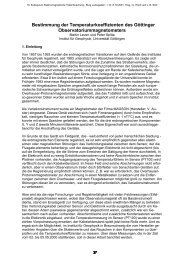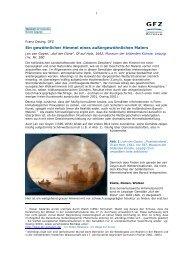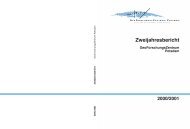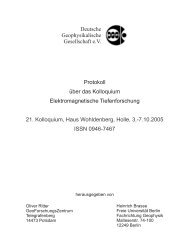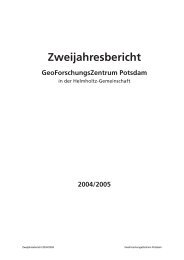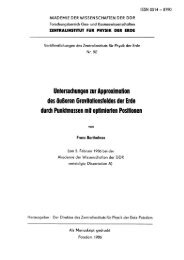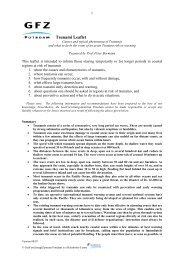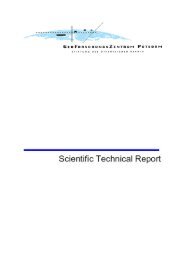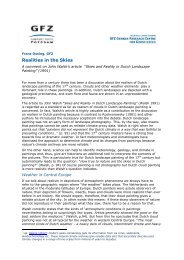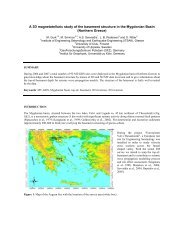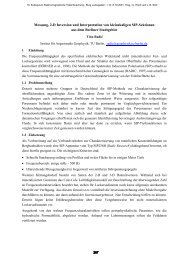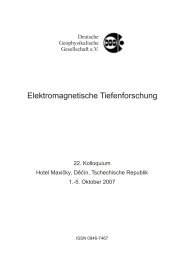und Überschiebungsgürtels - GFZ
und Überschiebungsgürtels - GFZ
und Überschiebungsgürtels - GFZ
Erfolgreiche ePaper selbst erstellen
Machen Sie aus Ihren PDF Publikationen ein blätterbares Flipbook mit unserer einzigartigen Google optimierten e-Paper Software.
Abstract 7<br />
Abstract<br />
Deformation processes in the early deformation stages of thrusting in growing fold-and-thrust belts and the<br />
role of factors controlling and localizing the deformation are still not well <strong>und</strong>erstood. There are only few<br />
natural examples or experimental studies to allow the identification of factors controlling initial states of<br />
deformation. In particular, the spatial interactions in curved fold-and-thrust belts or in segments striking<br />
obliquely to the convergence direction are rarely systematically examined.<br />
The Boomerang Hills Region (BHR), located at the eastern flank of the Central Andes close to the axis of<br />
the Bolivian Orocline, is an appropriate area to study such problems. There, oblique contraction is caused by a<br />
south-dipping basement interacting with a WSW-ENE to SW-NE convergence direction. In order to infer the<br />
controlling factors of deformation, the structural pattern associated with the active development of a new<br />
thrust sheet and the structural history of the adjacent foreland was examined.<br />
The detailed spatial-temporal relationships of Andean and pre-Andean structures within the BHR were<br />
investigated using a dense network of 100 reflection-seismic profiles for subsurface interpretation and<br />
structural modeling. In addition, satellite images and drainage pattern were interpreted to infer neotectonic<br />
activity. Modeling techniques included cross section balancing for validation and quantification of geological<br />
processes, horizon unfolding for kinematical interpretation, and critical taper estimates to derive the possible<br />
dynamic status.<br />
Results show that the main factor controlling the evolution of the Boomerang Hills Thrust Unit and the<br />
eastern flank of the Bolivian Orocline are paleogeographic features. The crystalline basement of the BHR<br />
comprises an inherited structure of several syn- and antiforms. Some of these structures were partly reactivated<br />
as minor reverse faults with associated small folds in the sedimentary cover at an early stage of the Tertiary<br />
foreland basin evolution. Basement faulting is probably a result of spatial problems linked to the initiation of a<br />
foreland basin in a heterogeneous crust.<br />
WNW-ESE striking normal faults were active in the foreland of the BHR in the Late Tertiary and show<br />
maximum activity during the intermediate state of foreland basin sedimentation. Further to the north, closer to<br />
the Brazilian Craton, normal faults are presently active. Foreland extension sums to 1.1%-1.5% and results<br />
from minor flexural extension due to bending of the Brazilian Shield lithosphere through Andean orogenic<br />
loading.<br />
The southern part of the BHR is represented by a young, evolving thrust sheet. Two zones can be<br />
differentiated along the Andean deformation front: (1) a W-E to NW-SE-striking frontal segment of<br />
predominantly orthogonal shortening, comprising a thrust / anticline system and accommodating at least 1400-<br />
2000 m horizontal shortening on the basal decollement ; (2) A WSW-ENE-striking lateral zone of oblique<br />
shortening comprised by a complex system of thin-skinned strike-slip faults and minor folds.<br />
The deformation front always follows a pronounced edge in the topography of the top basement surface<br />
close to the bo<strong>und</strong>ary of the Paleozoic basin. Usually, faults are located close to asperities in the top basement<br />
surface; fold axes trend parallel to the contours of basement depth.<br />
The orientation of the deformation front as well as the laterally varying structural style is the result of<br />
deformation localization and strain partitioning. Because of the impossibility to accommodate non-orthogonal<br />
contraction by oblique faulting close to the surface, strain partitioning must occur along the deformation front.<br />
Consequently, a N 35°E thrusting direction is divided into orthogonal and tangential components, both with<br />
respect to the orientation of the deformation front and to depth contours of the basement. The two components<br />
are accommodated by convergent and strike-slip structures, respectively, which join via a common detachment<br />
horizon.<br />
The Boomerang Hills Thrust Unit is affected by left-lateral shear as interpreted from the particle<br />
displacement field of an unfolded horizon. This shear is invoked by the spatially distributed accommodation of<br />
thrust movement along the obliquely striking deformation front.<br />
The N 35° thrusting direction of the Boomerang Hills Thrust Unit represents the orthogonal component of<br />
strain partitioning caused by the WNW-ESE orientation of the Subandean Zone with respect to a WSW-ENE<br />
convergence between the Andes and the Brazilian shield. The tangential component is compensated at the<br />
back of the Boomerang Hills Thrust Unit where a positive flower structure is present and strain partitioning is<br />
made possible via the detachment horizon.



